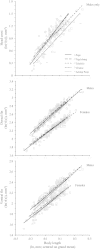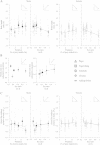How populations differentiate despite gene flow: sexual and natural selection drive phenotypic divergence within a land fish, the Pacific leaping blenny
- PMID: 24884492
- PMCID: PMC4055934
- DOI: 10.1186/1471-2148-14-97
How populations differentiate despite gene flow: sexual and natural selection drive phenotypic divergence within a land fish, the Pacific leaping blenny
Abstract
Background: Divergence between populations in reproductively important features is often vital for speciation. Many studies attempt to identify the cause of population differentiation in phenotype through the study of a specific selection pressure. Holistic studies that consider the interaction of several contrasting forms of selection are more rare. Most studies also fail to consider the history of connectivity among populations and the potential for genetic drift or gene flow to facilitate or limit phenotypic divergence. We examined the interacting effects of natural selection, sexual selection and the history of connectivity on phenotypic differentiation among five populations of the Pacific leaping blenny (Alticus arnoldorum), a land fish endemic to the island of Guam.
Results: We found key differences among populations in two male ornaments--the size of a prominent head crest and conspicuousness of a coloured dorsal fin--that reflected a trade-off between the intensity of sexual selection (male biased sex ratios) and natural selection (exposure to predators). This differentiation in ornamentation has occurred despite evidence suggesting extensive gene flow among populations, which implies that the change in ornament expression has been recent (and potentially plastic).
Conclusions: Our study provides an early snapshot of divergence in reproductively important features that, regardless of whether it reflects genetic or plastic changes in phenotype, could ultimately form a reproductive barrier among populations.
Figures



Similar articles
-
Population Variation in the Life History of a Land Fish, Alticus arnoldorum, and the Effects of Predation and Density.PLoS One. 2015 Sep 23;10(9):e0137244. doi: 10.1371/journal.pone.0137244. eCollection 2015. PLoS One. 2015. PMID: 26398191 Free PMC article.
-
Understanding the Spatial Scale of Genetic Connectivity at Sea: Unique Insights from a Land Fish and a Meta-Analysis.PLoS One. 2016 May 19;11(5):e0150991. doi: 10.1371/journal.pone.0150991. eCollection 2016. PLoS One. 2016. PMID: 27195493 Free PMC article.
-
Sex and differentiation: population genetic divergence and sexual dimorphism in Mexican goodeid fish.J Evol Biol. 2007 Sep;20(5):2048-55. doi: 10.1111/j.1420-9101.2007.01357.x. J Evol Biol. 2007. PMID: 17714321
-
Modifying effects of phenotypic plasticity on interactions among natural selection, adaptation and gene flow.J Evol Biol. 2008 Nov;21(6):1460-9. doi: 10.1111/j.1420-9101.2008.01592.x. Epub 2008 Aug 2. J Evol Biol. 2008. PMID: 18681916 Review.
-
Interpreting the genomic landscape of speciation: a road map for finding barriers to gene flow.J Evol Biol. 2017 Aug;30(8):1450-1477. doi: 10.1111/jeb.13047. J Evol Biol. 2017. PMID: 28786193 Review.
Cited by
-
Male pheromones and their reception by females are co-adapted to affect mating success in two subspecies of brown rats.Curr Zool. 2020 Oct 23;67(4):371-382. doi: 10.1093/cz/zoaa066. eCollection 2021 Aug. Curr Zool. 2020. PMID: 34671704 Free PMC article.
-
Land colonisation by fish is associated with predictable changes in life history.Oecologia. 2016 Jul;181(3):769-81. doi: 10.1007/s00442-016-3593-6. Epub 2016 Mar 1. Oecologia. 2016. PMID: 26932469
-
Population Variation in the Life History of a Land Fish, Alticus arnoldorum, and the Effects of Predation and Density.PLoS One. 2015 Sep 23;10(9):e0137244. doi: 10.1371/journal.pone.0137244. eCollection 2015. PLoS One. 2015. PMID: 26398191 Free PMC article.
-
An Analysis of Predator Selection to Affect Aposematic Coloration in a Poison Frog Species.PLoS One. 2015 Jun 25;10(6):e0130571. doi: 10.1371/journal.pone.0130571. eCollection 2015. PLoS One. 2015. PMID: 26110826 Free PMC article.
-
Understanding the Spatial Scale of Genetic Connectivity at Sea: Unique Insights from a Land Fish and a Meta-Analysis.PLoS One. 2016 May 19;11(5):e0150991. doi: 10.1371/journal.pone.0150991. eCollection 2016. PLoS One. 2016. PMID: 27195493 Free PMC article.
References
Publication types
MeSH terms
LinkOut - more resources
Full Text Sources
Other Literature Sources

